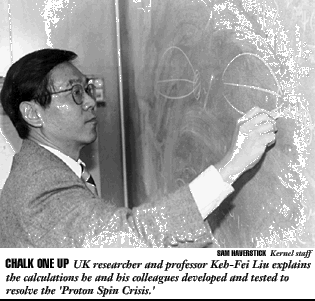UK research solves crisis
 By
Jessica Bean
By
Jessica Bean
Staff Writer
Three UK physicists have uncovered a major breakthrough that has baffled nuclear and particle researchers for years. Physicist Keh-Fei Liu, and doctoral associates, Shao-Jing Dong and Jean Francois Lagae, have solved the proton-spin crisis that has been a puzzle since1987.
Using a supercomputer, it took them four and a half years to verify their theory.
According to Physics and Astronomy Chairman Kumble Subbaswamy, the solving of the proton-spin crisis will have profound effects on the physics community, UK and Kentucky in general.
"Anytime a major puzzle is solved it brings notice and prestige to the University as a whole and to Kentucky," Subbaswamy said.
In terms of reputation, UK is not in the top tier of institutions, so when something like this happens, people notice, he said. The researchers' results already have been published this fall in Physical Review Letters .
The problem concerned protons and quarks. Protons are particles that connect with neutrons to embody the center of an atom. Quarks are particles that combine with fluons to form the protons.
Since the '60s, it has been generally accepted by physicists that every proton is made up of three quarks.
Therefore, it had been concluded that the spin of each proton was made up of the spins of the three quarks inside it.
In Europe, an experiment was conducted in 1987 revealing that the quark spins contributed only moderately to the proton-spin, which created a dilemma.
Liu, Dong and Lagae began their work in California in 1991. After more than 6,000 hours spent concentrating on the fundamental theory of the proton-spin, they were finally able to solve the puzzle.
Instead of using a model, as researchers had done in the past, they proved their hypothesis using a computer simulation.
Previous futile attempts by other researchers had been made in the past to solve this puzzle. However, varying numerical techniques provided different answers each time.
Unlike the prior attempts, the computer simulation was able to give the physicists precise answers that could not have been found using a model.
Quark and anti-quark pairs are created from a vacuum, and these affect the spin of the proton
The researchers' breakthrough is the first of this nature for the physics and astronomy department in quite a while.
According to Subbaswamy, discoveries like these are very rare and therefore extremely beneficial for UK.
"This is the sort of thing that we are lucky if it happens once
every five or 10 years," Subbaswamy said.
Copyright 1995, Kernel Press Inc.